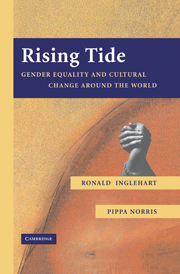Book contents
- Frontmatter
- Contents
- List of Tables
- List of Figures
- Preface and Acknowledgments
- PART I THE CAUSES OF THE RISING TIDE
- 1 Introduction: Explaining the Rising Tide of Gender Equality
- 2 From Traditional Roles toward Gender Equality
- 3 Religion, Secularization, and Gender Equality
- PART II THE CONSEQUENCES OF THE RISING TIDE
- CONCLUSIONS
- Appendix A
- Appendix B
- Appendix C Technical Note on the Major Scales
- Notes
- Select Bibliography
- Index
1 - Introduction: Explaining the Rising Tide of Gender Equality
Published online by Cambridge University Press: 22 October 2009
- Frontmatter
- Contents
- List of Tables
- List of Figures
- Preface and Acknowledgments
- PART I THE CAUSES OF THE RISING TIDE
- 1 Introduction: Explaining the Rising Tide of Gender Equality
- 2 From Traditional Roles toward Gender Equality
- 3 Religion, Secularization, and Gender Equality
- PART II THE CONSEQUENCES OF THE RISING TIDE
- CONCLUSIONS
- Appendix A
- Appendix B
- Appendix C Technical Note on the Major Scales
- Notes
- Select Bibliography
- Index
Summary
During the late twentieth century, the issue of gender equality once again became a major issue on the global agenda. The UN Decade for Women, which ended in 1985, initiated the integration of women into development, triggering the formation of thousands of women's organizations and networking them across the world. The trend accelerated during the following decade. In 1993, the Vienna World Conference proclaimed that women's rights were human rights; in 1994, the Cairo International Conference on Population and Development placed women's empowerment and health at the center of sustainable development programs. Two years later, the Beijing Fourth World Conference on Women adopted a platform seeking to promote and protect the full enjoyment of human rights and fundamental freedoms for all women. Although there has been substantial progress toward gender equality in much of the world, great disparities persist, as systematic indicators demonstrate.
In many places, most women's lives remain wretched. Afghanistan was among the most oppressive regimes, with women and girls living under an extreme version of Islamic law introduced by the Taliban. They were denied education, barred from the workplace, and unable to venture out in public without a male companion and the full head-to-toe covering of the burqa. They suffered from limited access to health care, including laws forbidding treatment of women by male doctors, and pervasive threats of domestic and state-legitimated violence.
- Type
- Chapter
- Information
- Rising TideGender Equality and Cultural Change Around the World, pp. 3 - 28Publisher: Cambridge University PressPrint publication year: 2003
- 3
- Cited by



